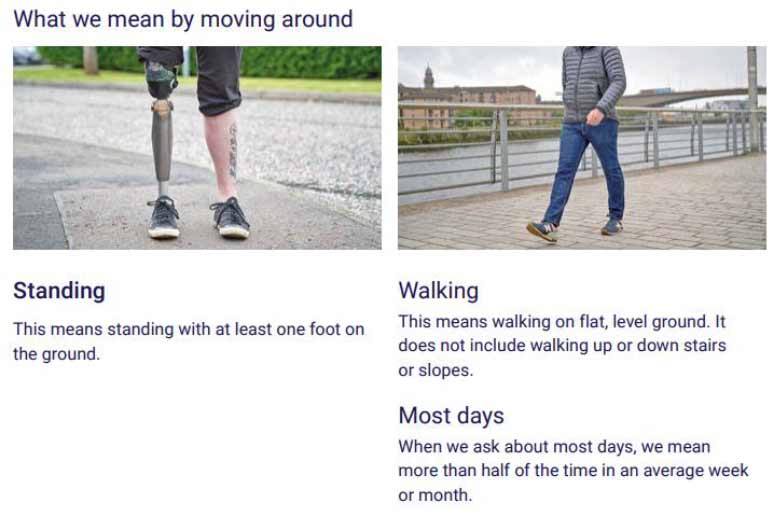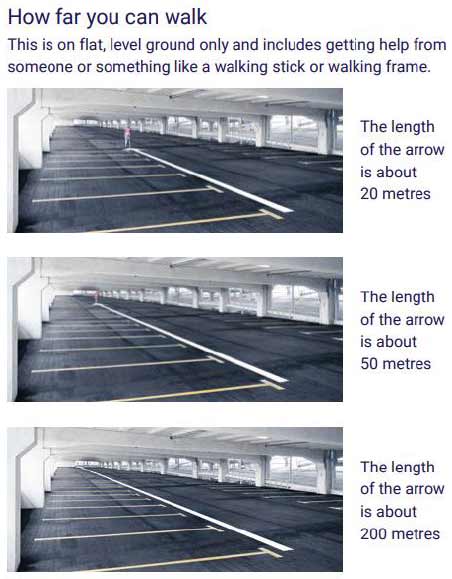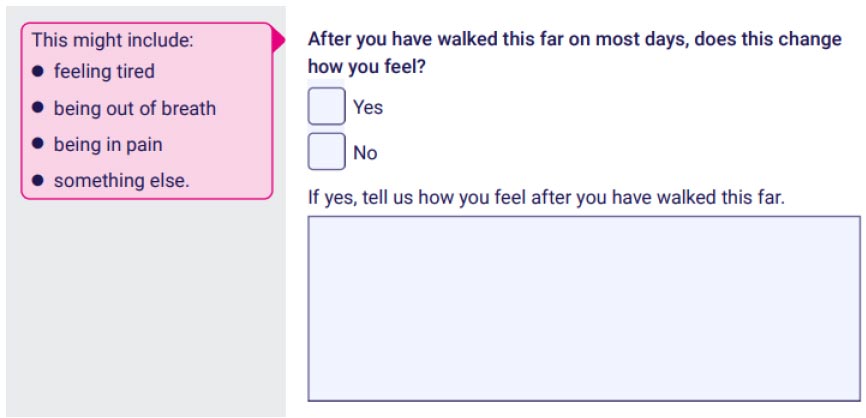Adult Disability Payment: Consultation on the Mobility Component
The Scottish Government's consultation on the mobility component of Adult Disability Payment (ADP) gives people the opportunity to give their views on the eligibility criteria. The findings will inform the independent review of Adult Disability Payment commencing later this year.
Section 1: The moving around activity
Background
The purpose of this activity is to consider a person’s ability to move around without severe discomfort, such as breathlessness, pain, or fatigue. This activity looks at how a person moves around on the types of surfaces normally found outdoors, like pavements and kerbs. It does not include walking up or down stairs or slopes. The Adult Disability Payment application form has been designed to communicate this clearly in response to feedback about the PIP application process.
The activity looks at how far a person can stand and move around. Standing means standing with at least one foot on the ground. This includes the ability to stand and then move up to 20 metres, up to 50 metres, up to 200 metres, and over 200 metres.
The application form for Adult Disability Payment includes guidance for people making an application on the factors that are considered when looking at how far a person can move around. These include:
- how quickly the person can move,
- the risk of falling or injury,
- breathlessness, pain, or fatigue,
- the way the person moves, and
- symptoms or side-effects from moving around.
The criteria for the moving around activity
Depending upon how far a person can stand and move, they may score between 0 and 12 points for this activity:
Table 2 The criteria for the moving around activity
a. Can stand and then move more than 200 metres, either aided or unaided.
Points 0
b. Can stand and then move more than 50 metres but no more than 200 metres, either aided or unaided.
Points 4
c. Can stand and then move unaided more than 20 metres but no more than 50 metres either aided or unaided.
Points 8
d. Can stand and then move using an aid or appliance more than 20 metres but no more than 50 metres, either aided or unaided.
Points 10
e. Can stand and then move more than 1 metre but no more than 20 metres, either aided or unaided.
Points 12
f. Cannot, either aided or unaided,—
(i) stand, or
(ii) move more than 1 metre.
Points 12
“Stand and then move” describes a person’s ability to stand and then move while remaining standing. It does not include a person who stands and then transfers into a wheelchair or similar device. People who need a wheelchair or similar device to move a distance should not be considered able to stand and move that distance.
An “aid or appliance” that a person may use to support their physical mobility may include any of the following items, which are not limited to:
- a walking stick,
- crutches,
- a Zimmer frame, and
- a prosthetic or prostheses.
The definition of “aided” includes supervision, prompting or assistance, so any of these could also be considered an aid when a person is completing an activity.
The first set of questions are about the moving around activity which is described in section 1 of the consultation paper. They cover:
- Clarity of the moving around activity criteria
- Evidence about the moving around activity
- Changes to the moving around part of the application form
- Changes to how we make decisions about the moving around activity
- Other opportunities to change to moving around activity
1. Do you agree or disagree that the moving around activity criteria for Adult Disability Payment are easy to understand?
If you are unsure of the moving around activity criteria, please refer to page 18 of the consultation paper.
Agree / Disagree / Don’t know
1(a). Please give reasons for your answer, outlining which parts you think are easy or difficult to understand and why.
1(b). How could we make the moving around activity criteria easier to understand?
Evidence on the moving around activity
Research findings
We know that some people feel that using a test that is based solely on the distance a person can walk is not a good way to know who has the most significant mobility needs[12]. For example, whilst a person may be able to stand and move a few metres, they may not be able to achieve all the things they want to in life due to their mobility needs. This could include accessing healthcare services or taking part in a wider range of personal and social interests[13].
Some health conditions may potentially be difficult to assess against a specific distance, either because they are a progressive condition or because the person’s condition may vary[14]. This could include conditions such as asthma, heart disease, or multiple sclerosis.
Disabled people have described to us difficulties with feeling like they must fit into the right box on a form as part of PIP, because the eligibility criteria does not take into account all of a person’s circumstances[15]. As Adult Disability Payment uses the same criteria as PIP, this means that the same criticism could be applied to Adult Disability Payment. Some people have also told us that they feel like the test is unfair because it is “deficits-based”, in that people feel like it is focused on what they cannot do rather than on what they can.
Some people also feel that it is unfair to not consider the cost of acquiring and maintaining mobility aids, such as electric wheelchairs or scooters. This is because these costs can have a significant impact upon disabled people’s disposable income[16], such as the cost of:
- repairs,
- maintenance,
- breakdown cover, and
- fuel or electricity.
We also know that some people feel it is unfair not to take account of the additional costs associated with the need to use taxis and vehicles more regularly than someone without their disability or condition[17].
On the eligibility criteria, it was suggested that the use of distances could discourage people from undertaking physical activity that might be beneficial to their health because they fear losing entitlement. One study noted that almost half of the respondents (47 percent) were fearful of losing benefits if they are seen to be more active, with more than half (55 percent) saying they were more likely to be active if benefits were not at risk of being withdrawn[18].
Two fifths of respondents to another survey[19] said that fear of benefits being withdrawn prevented them from being more active. This was particularly common amongst people with communication, social or behavioural conditions, and mental health conditions.
It is possible that using a more individual model that looks at the barriers a person faces could lead to more detailed questions and the need for consultations[20]. This could also lead to outcomes that are potentially very subjective and inconsistent.
The use of distances as an objective indicator of the severity of disability is disputed by some, as it is felt to be too generic and fails to consider individual circumstances.
In the context of PIP, it was noted that the way in which assessments were weighted towards the views of a privately employed healthcare professional was problematic[21]. The approach used in PIP assessments marginalised self-assessment by disabled people and reduced the levels of supporting information requested by professionals who already know disabled people[22]. We took this evidence into account when setting up Adult Disability Payment.
Adult Disability Payment consultations only take place when there is no other practical way to gather the information we need, and consultations are undertaken by Social Security Scotland staff, not by private companies. We start assessments by trusting what people tell us about their disability or condition is accurate, and we seek supporting information from people or medical professionals who already know the person.
Many of the academics we spoke to were positive about the changes to the application and decision-making processes, including how that would impact upon the moving around activity. This includes:
- starting from a position of trust with disabled people,
- increased training requirements for our practitioners who undertake consultations with disabled people,
- recognising the importance of social, cultural and environmental factors in guidance,
- the consultation process being less challenging or “aggressive” than PIP, and
- a clear commitment to award support people are entitled to, rather than restricting this for budgetary reasons.
Consultation findings
During the Consultation on Disability Assistance in 2019, several respondents suggested changing the threshold for descriptor (e) from 20 metres to 50 metres.
Reasons given included:
- 20 metres was too limited a distance to be of use,
- that 20 metres was designed to reduce peoples’ benefits or prevent them leading a full quality of life, and
- it was better to return to the “virtually unable to walk” test which was used to establish entitlement to the higher rate of the mobility component for Disability Living Allowance (DLA).
Similar numbers of respondents wanted to see the “distance moved” rule to be scrapped entirely on the grounds that it is too simplistic or arbitrary and does not account for things encountered in everyday life such as navigating furniture.
A small number of respondents felt that the main issue was the way in which PIP assessors applied the criteria, or that the way in which the criteria was framed was deliberately designed to catch people out. This is also a factor that we have acted to improve within the Adult Disability Payment system: practitioners are provided with extensive guidance about how to apply the criteria so that it is applied fairly and equally to each person that applies.
2. Are there any other issues with the moving around activity that we have not captured above?
Yes / No / Don’t know
2(a). If you said “yes,” what other issues with the moving around activity do you think need to be considered?
2(b). In your view, what are the positive aspects of the moving around activity that we have not captured above?
Improvements made to Adult Disability Payment
The application form
We have sought to address some of the concerns raised about the moving around criteria with the introduction of Adult Disability Payment. We have made it clearer in the guidance accompanying the application form what the activity considers:

We also recognise that it can be difficult to estimate how far each distance might be. The Adult Disability Payment application form has been designed to help people better understand how far each distance is, as shown in the diagram below:

The application form for Adult Disability Payment also includes prompts next to each question, to help us capture a better understanding of the impact moving around has on someone. In particular, factors such as tiredness, breathlessness and pain are given more prominence:

3. How effective do you think the moving around section of the application form is at helping us understand a person’s mobility needs?
Please only answer in relation to the changes to the moving around section of the application form that are outlined on page 22 in the consultation paper.
Very effective / effective / somewhat effective / not very effective / not effective at all
Please give reasons for your answer
How we make decisions
In addition to making improvements to the application form, we have provided clear guidance for both people applying for and receiving Adult Disability Payment and for our Social Security Scotland case managers about how the eligibility criteria for this activity are applied. This includes more fairly and consistently considering environmental, cultural, and social factors.
We usually seek to collect one piece of supporting information from a formal source, such as from a GP or a support worker. This information only needs to determine, on the balance of probabilities, that the person’s disability or condition is consistent with the needs detailed on their application. A piece of supporting information can be something like a social care assessment, medical report, or prescription list. We place equal consideration on all sources of information, including information from a person’s family, carers and friends.
A person is only be invited to take part in a consultation when there is no other practicable way to understand their needs. Social Security Scotland practitioners fully discuss the impact of completing the activity, starting from a position of trust in what people tell us as being accurate. We have also removed functional assessments, including physical examinations, as part of the application and decision-making process.
We recognise that a significant issue with PIP assessments also related to assessors making informal observations, for example, about the way a person moved around. Our practitioners only make informal observations whilst a consultation is taking place. The person, or person accompanying them, must be given the opportunity to respond to the observations. This is a significant change to the UK Government system where an assessor can make assumptions about the person without telling them and can do so before or after the assessment has taken place.
4. What impact do you think the changes to how we make decisions on the moving around activity have on understanding a person’s mobility needs?
Please only answer in relation to the changes to decision making processes for the moving around activity that are outlined on page 24 in the consultation paper.
Significant positive impact / a positive impact / neither positive nor negative / a negative impact / significant negative impact
Please give reasons for your answer
5. If there was an opportunity to change the moving around activity criteria, what changes would you make (if any)?
Please provide detail about:
- Why you think changes are necessary
- What changes you would suggest
- Could there be any unintended consequences
5(a). If you proposed changes, what positive impacts could these have, and for who?
5(b). If you proposed changes, what negative impacts could these have, and for who?
Contact
Email: ADPreview@gov.scot
There is a problem
Thanks for your feedback